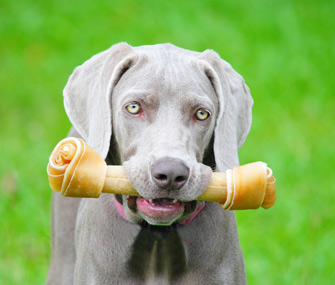Is It Safe to Give My Dog a Rawhide?
Published on January 28, 2017
Skip To

So when clients ask me if it’s safe to give their dogs rawhides, I have to say that it depends on the individual dog. Labrador Retrievers and Pit Bulls, for instance, tend to be heavy-duty chewers and gulpers. They are among the dogs who are most likely to bite off and swallow large pieces of rawhide. Those chunks can become stuck in the esophagus, stomach or intestinal tract and may pose a choking risk or require emergency surgery or endoscopic removal. Other dogs, though, may be content to gnaw on them for hours or days.
That’s just one of the reasons why everyone, including veterinarians, has a different opinion on whether it’s okay to give your dog a rawhide. I asked two of my colleagues, Tony Johnson, DVM, and Tina Wismer, DVM, to weigh in with their experiences.
Know the Hazards
There’s a small but real risk of a
blockage if a dog swallows a piece of rawhide, says Dr. Johnson, an emergency
and critical-care specialist in Indianapolis. “I have seen many esophageal foreign
bodies in smaller dogs with rawhides,” he says. He’d rather not give rawhides to dogs
at all. In his opinion, the ideal dog treat or toy should be either completely
consumable in 30 seconds or as inedible and difficult to consume as possible. At home, though, his wife — who is also a veterinarian — gives rawhides to their three dogs with no problem.
“Stomach acid will break down small pieces of rawhide,” says Dr. Wismer, a veterinary toxicologist and medical director of the ASPCA Animal Poison Control Center. “That’s not a problem. The issue is if they ingest a piece that’s big enough to leave the stomach whole, and then it gets stuck in the intestinal tract.”
Some dogs break teeth when chewing rawhides. There’s a higher risk of that with pressed rawhides because they are more dense, Dr. Wismer says.
Rawhide Safety
The way rawhides are prepared can also
be a concern. In the United States, rawhides are washed with degreasers and
detergents, sterilized with hydrogen peroxide and then thoroughly rinsed. The
hides are refrigerated until they are processed to keep them fresh. But rawhides made in other countries may be
produced under less stringent practices. Dr. Wismer notes, however, that there
has been only a single documented incident of imported rawhides contaminated
with toxins. “This dates to the early 1980s, when
there was one shipment of rawhides that was contaminated with arsenic,” she
says.The Food and Drug Administration does not regulate the manufacture of rawhides in this country. It’s up to consumers to call U.S. manufacturers and ask about their practices. That’s a heck of a lot easier to do with a manufacturer in the U.S. than one in China.
For that reason, I only recommend rawhide products made in the United States. Dr. Johnson also prefers domestically made rawhides. Don’t hesitate to call the manufacturer and ask if their rawhides are completely sourced and made in the U.S.
Like any product from an animal source, rawhides can also be contaminated with salmonella, says Dr. Wismer. The same is true for pig ears, cow ears and similar items, she adds. Salmonella typically affects younger dogs and those with compromised health, and healthy dogs tend to be less prone to salmonella infection than humans. But it can be an issue for people in the household who come in contact with the rawhide. Young children, seniors and people with compromised immune systems are most at risk. Don’t let little kids play with or chew on rawhides, not even long enough for you to snap a photo for Instagram. And wash your hands after giving your dog a rawhide or putting one away.
The Upside
So is there an upside to giving your dog a rawhide? There may be. Chewing a rawhide helps to keep dogs mentally stimulated and out of trouble.What about a rawhide’s rumored teeth-cleaning properties? Anything that rubs against the teeth can help, but letting a dog chew a rawhide is no substitute for daily tooth-brushing or a professional cleaning that gets under the gumline where bacteria lurk.
What’s the verdict? For the vast majority of dogs, I’ve seen very few accidents from chewing rawhides other than digestive upset. If you choose to give your dog rawhide treats, know his chewing style, select one that’s large enough that he can’t swallow it whole and only provide it when you can monitor the chewing. If he’s a gulper, not a gnawer, keep an eye on him while he’s chewing to make sure he doesn’t break off and swallow pieces. Put the rawhide away when you can’t supervise. Chew on!
More on Vetstreet:

